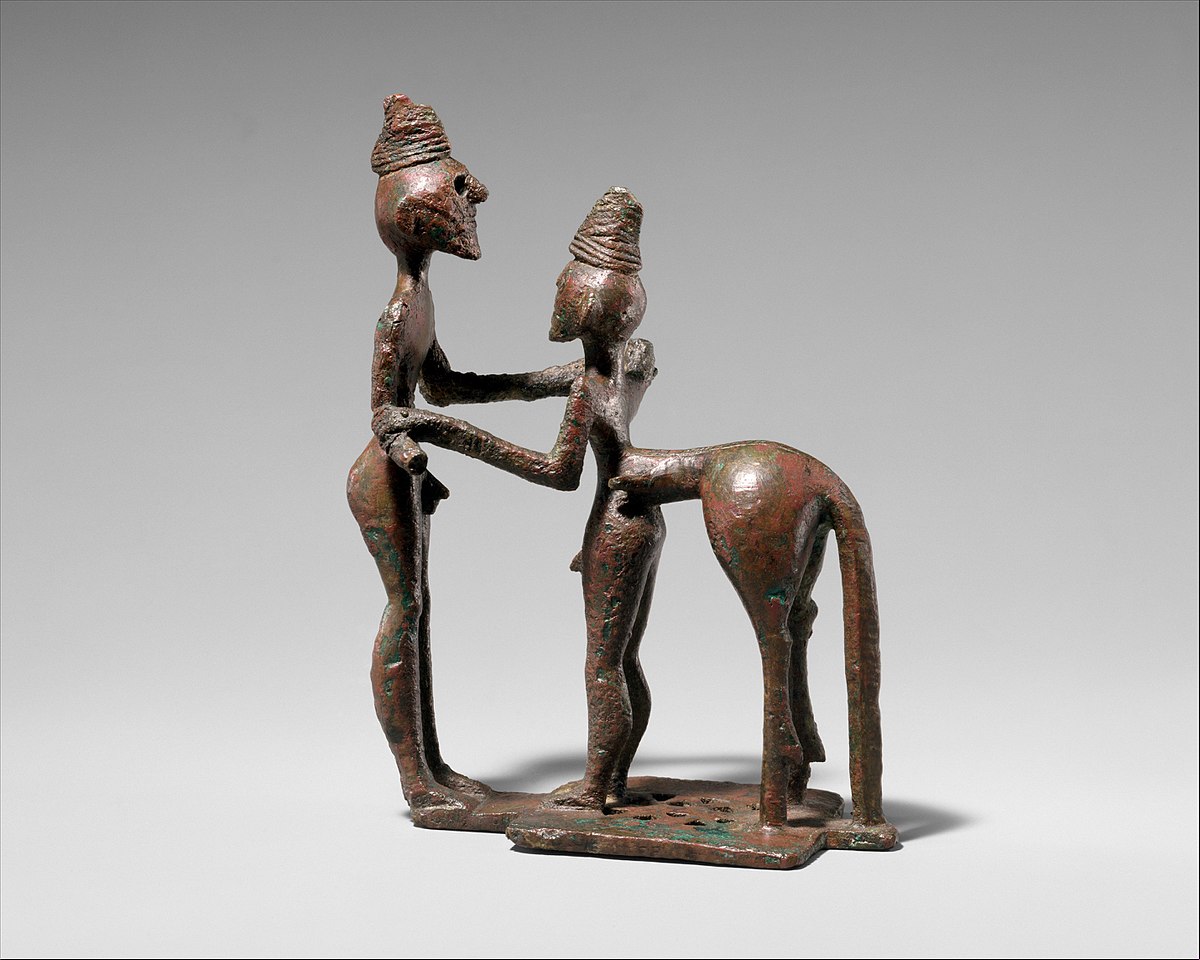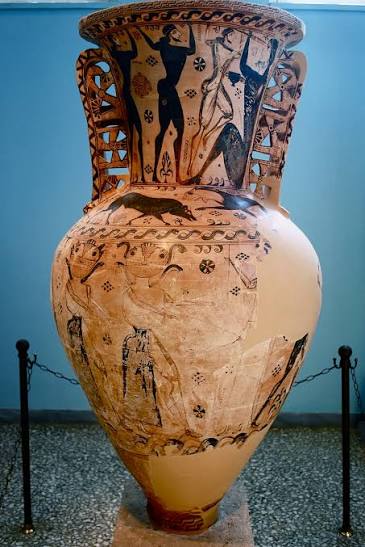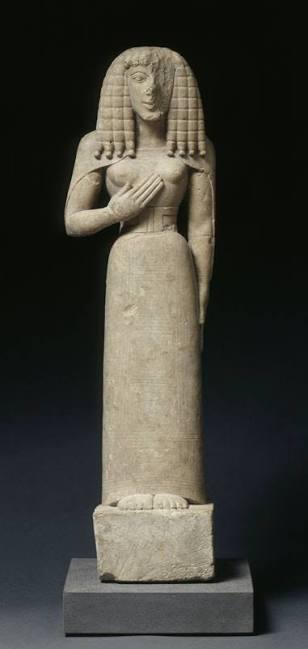Art History: Chapter 8 - Art of Ancient Greece
1/20
There's no tags or description
Looks like no tags are added yet.
Name | Mastery | Learn | Test | Matching | Spaced |
|---|
No study sessions yet.
21 Terms
Background
Rose after Aegean period ended
Autonomous city states/polis
Aeropolis: Major city on mountain
Democratic government that inspired our own
Voting rights only for wealthy male landowners
Europeans after this era valued naturalistic and idealistic art
Classical: Most naturalistic and idealistic art
Became more expressive later on
Geometric Period (900 - 700 BC)
Forms/figures are reduced to geometric shapes
Friezes: Registers
Pots are in automorphic form (lip, neck, handle, shoulder, body, foot), though not all have every single one
Lots of different standardized types of pottery

Funerary Krater
Visual
Made of terracotta
2 ft high
Depicts humans in geometric motifs such as diamonds, triangles, circles, and meanders
Top frieze depicts deceased laying in bed with people surrounding in mourning pose
Second frieze shows chariots with horses in echelon form
Humans are naturalistic & abstract, with triangular upper bodies, no waist thin bodies, and elongated legs
Iconographic
Made in Geometric Period
Were used to mark grave sites where people were buried underneath
Since bottom of the vase is opened, possible that liquid was poured in the top as an offering for the decease or used to drain off rainwater
Geometric motifs symbolized continuity, the after life, and societal values
Meander specifically symbolized the eternal journey of life

Men and Centaur
Visual
Made of bronze
Naturalistic
Detailed narrative of combat between man and monster, hinting at man’s impending victory
Depicts centaur dying from a spear pierced through its body as a man grapples it
Iconographic
Made in Geometric Period
Possibly originally functioned as a votive offering dedicated to the gods in exchange for blessings
Orientalizing Period (700 - 600 BC)
Influenced by the Ancient Near East & Egypt
Connection to other civilizations through trades, garnering people and ideas
Linear, geometric styles with orientalizing motifs, such as animals and florals

Eleusis Amphora
Visual
Made of terracotta
An amphora pot: Two-handled storage vessel
In Porto-Attic Style: Depicted scenes from Greece’s heroic past, including the myths of heroes
Continous curvilinear forms all over vase
Figures are in black silhouettes and outlines
Lip frieze on the neck of the vase shows story of Odysseus and Polyphemus
Odysseus piercing Polyphemus’s eye is shown
Frieze on the body of the vase tells the story of Perseus and the Gorgons/Medusa
Medusa’s head cut off is shown
Gorgon sisters have snakes for hair, snakes emerging from their shoulders, teeth-like spikes, giant staring eyes and deformed faces
Giant heads look like double cauldrons
Possibly running over the sky or ocean
Orientalizing motifs of rosettes around humans and animals
Iconographic
Made in Orientalizing Period
Made using a pottery wheel
Found with the body of a 10 year old boy in it
Are the largest figures ever found on a Greek pot
Both myths have symbolizing dealing with sight
Double cauldrons were used as votive offerings to gods (association with seeing the divine and being awed at the sight of gods)
Rosettes symbolized rebirth, regeneration, and the cyclical nature of life
Pot was possibly a deeper red instead of pale brown, making the Gorgons more frightening than they appear now

Olpe
Visual
Made of ceramic with black figure decoration
Rosettes surround animals and decorate the neck of the vase
Has bits of red hue
Black figures stand out on the clay
Incised with sharp tool to expose the clay
Some figures are in profile while some are looking at you
Iconographic
Made in Orientalizing Period
City of Corinth invented black figure painting that became popular in Greece

Lady of Auxerre
Visual
Made of limestone
Naturalistic
Free standing, carved in the round, and frontal & stiff
Has flat body and oversized hand touching the chest
Iconographic
Made in Orientalizing Period
Were common statues in Ancient Greece
Depicts a korai, female votives that were offerings to the gods in exchange for blessings
Men were kouros and nude while women were korai and clothed
Inspired by life-sized stone figures of Egyptians pharaohs/gods
Unknown function because she was found in Auxerre museum basement
Archaic Period (600 - 480 BC
Art focused on rigidity and symmetry in stone sculptures
They love marble
Sanctuary of Apollo
Visual
Iconographic
Treasury of the Siphnians
Visual
Made of marble
Originally all painted
Consisted of acroterians, pediment, entablature (frieze + architrave), caryatids, and pedestals
Iconographic
Made in the Archaic Period
Part of the Sanctuary of Apollo
Used to hold offerings and demonstrate the wealth of the Siphnians
Temple of Aphaia
Visual
Made of limestone coated into marble
Is a megaron with a pronaos (front porch), cella (main room), and a peristyle (columns surrounding the inside)
Has a frieze with triglyphs and metopes
Iconographic
Made in Archaic Period
Dedicated to the goddess Aphaia
Cella housed the cult statue of Aphaia
Only priest/priestess can go inside
Public rites were held outside on an altar
Was built with entrasis: which is a slight curve put in the shaft to correct vision of concavity to make a straight line
West Pediment
Visual
Made of marble
Consists of naturalistic figures
Figures in active poses to fit into triangular space
Middle central figure is Athena, the goddess of war and wisdom
Iconographic
Made in Archaic Period
Part of Temple of Aphaia
Represents a specific battle during the Trojan War
Dying Warrior 1 & 2
Visual
Made of marble
Are naturalistic with archaic smiles
#1’s body is in an awkward position
#2’s body is in a more naturalistic, relaxed position
Iconographic
Made in Archaic period
Part of Temple of Aphaia
Difference shows the shift in increased naturalism
Represents the deaths of fallen soldiers
New York & Anavysos Kouros
Berlin & Peplos Kore
Peplos Kore (Smarthistory)
Exekias
Early Classical Period (480 - 450 BC)
Art reflected the Greek philosophical ideas of humanism, rationalism, and idealism
Warriors and mythological beings shown in human, idealistic forms
Socrates valued balance within oneself
Stoicism is key to Greek philosophy
Two wars from Persian invasion caused changes in Greek art
Powerful presence affected their sense of pride and how they communicated with other places
Warrior
Kritios Boy